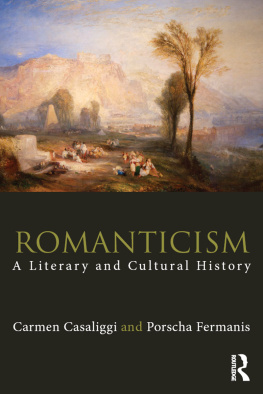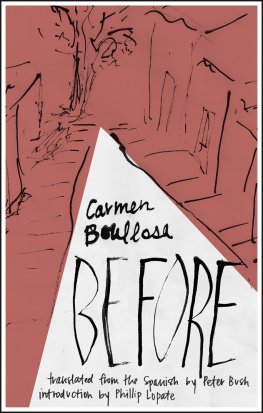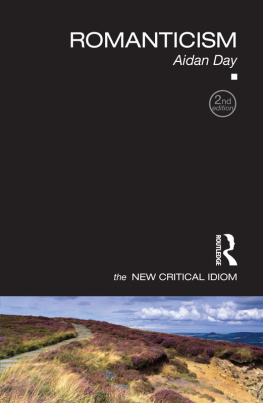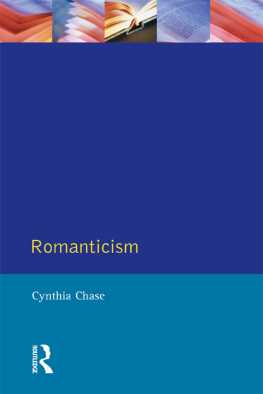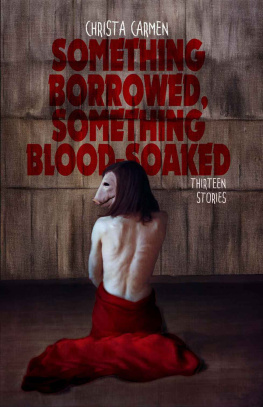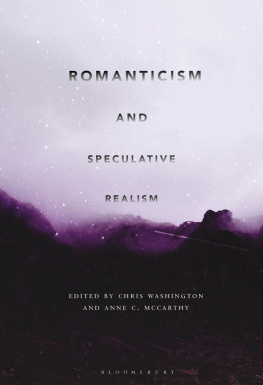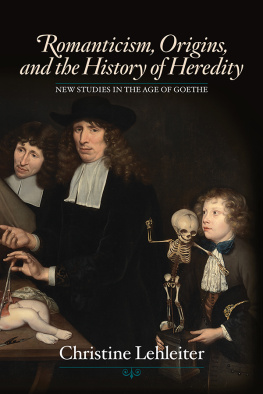Carmen Casaliggi - Romanticism: A Literary and Cultural History
Here you can read online Carmen Casaliggi - Romanticism: A Literary and Cultural History full text of the book (entire story) in english for free. Download pdf and epub, get meaning, cover and reviews about this ebook. year: 2016, publisher: Routledge, genre: Art. Description of the work, (preface) as well as reviews are available. Best literature library LitArk.com created for fans of good reading and offers a wide selection of genres:
Romance novel
Science fiction
Adventure
Detective
Science
History
Home and family
Prose
Art
Politics
Computer
Non-fiction
Religion
Business
Children
Humor
Choose a favorite category and find really read worthwhile books. Enjoy immersion in the world of imagination, feel the emotions of the characters or learn something new for yourself, make an fascinating discovery.
- Book:Romanticism: A Literary and Cultural History
- Author:
- Publisher:Routledge
- Genre:
- Year:2016
- Rating:4 / 5
- Favourites:Add to favourites
- Your mark:
- 80
- 1
- 2
- 3
- 4
- 5
Romanticism: A Literary and Cultural History: summary, description and annotation
We offer to read an annotation, description, summary or preface (depends on what the author of the book "Romanticism: A Literary and Cultural History" wrote himself). If you haven't found the necessary information about the book — write in the comments, we will try to find it.
Romanticism: A Literary and Cultural History — read online for free the complete book (whole text) full work
Below is the text of the book, divided by pages. System saving the place of the last page read, allows you to conveniently read the book "Romanticism: A Literary and Cultural History" online for free, without having to search again every time where you left off. Put a bookmark, and you can go to the page where you finished reading at any time.
Font size:
Interval:
Bookmark:

Romanticism
The Romantic period coincided with revolutionary transformations of traditional political and human rights discourses, as well as witnessing rapid advances in technology and a primitivist return to nature. As a broad global movement, Romanticism strongly impacted on the literature and arts of the late eighteenth and early nineteenth centuries in ways that are still being debated and negotiated today.
Examining the poetry, fiction, non-fiction, drama and the arts of the period, this book considers:
important propositions and landmark ideas in the Romantic period;
key debates and critical approaches to Romantic studies;
new and revisionary approaches to Romantic literature and art;
the ways in which Romantic writing interacts with broader trends in history, politics and aesthetics;
European and global Romanticism;
the legacies of Romanticism in the twentieth and twenty-first centuries.
Containing useful, reader-friendly features such as explanatory case studies, chapter summaries and suggestions for further reading, this clear and engaging book is an invaluable resource for anyone who intends to study and research the complexity and diversity of the Romantic period, as well as the historical conditions which produced it.
Carmen Casaliggi is a Senior Lecturer in Nineteenth-Century Literature at Cardiff Metropolitan University, UK.
Porscha Fermanis is an Associate Professor in Romantic Literature at University College Dublin, Ireland.
Romanticism
A Literary and Cultural History
Carmen Casaliggi and Porscha Fermanis

First published 2016
by Routledge
2 Park Square, Milton Park, Abingdon, Oxon OX14 4RN
and by Routledge
711 Third Avenue, New York, NY 10017
Routledge is an imprint of the Taylor & Francis Group, an informa business
2016 Carmen Casaliggi and Porscha Fermanis
The right of Carmen Casaliggi and Porscha Fermanis to be identified as author of this work has been asserted by him/her in accordance with sections 77 and 78 of the Copyright, Designs and Patents Act 1988.
All rights reserved. No part of this book may be reprinted or reproduced or utilised in any form or by any electronic, mechanical, or other means, now known or hereafter invented, including photocopying and recording, or in any information storage or retrieval system, without permission in writing from the publishers.
Trademark notice: Product or corporate names may be trademarks or registered trademarks, and are used only for identification and explanation without intent to infringe.
British Library Cataloguing-in-Publication Data
A catalogue record for this book is available from the British Library
Library of Congress Cataloging-in-Publication Data
Names: Casaliggi, Carmen, author. | Fermanis, Porscha, 1975- author.
Title: Romanticism: a literary and cultural history/Carmen Casaliggi and Porscha Fermanis.
Description: Milton Park, Abingdon, Oxon; New York: Routledge, 2016. | Includes bibliographical references and index.
Identifiers: LCCN 2015037829 | ISBN 9780415679077 (hardback: alk. paper) | ISBN 9780415679084 (pbk.: alk. paper) | ISBN 9781315749501 (ebook)
Subjects: LCSH: Romanticism.
Classification: LCC PN603.C37 2016 | DDC 809/.9145dc23LC record available at http://lccn.loc.gov/2015037829
ISBN: 978-0-415-67907-7 (hbk)
ISBN: 978-0-415-67908-4 (pbk)
ISBN: 978-1-315-74950-1 (ebk)
Typeset in Times New Roman
by Sunrise Setting Ltd, Paignton, UK
Contents
Over the past thirty years, literary scholars have increasingly questioned the reiteration of familiar stories about our literary past, making the writing of literary history a more tentative but perhaps more necessary project than ever before. As David Perkins has pointed out in the opening pages of Is Literary History Possible? (1992), two of the three principal assumptions of traditional literary history that works are formed by their historical contexts, that changes in literary forms and styles take place developmentally and that these changes are the products of an overarching idea have gradually been eroded by less teleological ways of thinking about periodicity and by the inclusion of previously neglected and less easily accommodated writers in literary canons. In the context of Romantic studies this destabilisation of periods and canons has led to concerns about how to characterise the relationship between eighteenth-century, Romantic and Victorian writing, and ultimately to fears that the term Romanticism itself may have become obscured and even meaningless.
Until recently these anxieties have been felt primarily at the level of academic scholarship, but they are now permeating classrooms and pedagogical discussions. Students of British Romanticism will no longer encounter just the Big Six Romantic poets in their seminars and lectures, but will most likely be exposed to the work of female, working-class, transatlantic, Scottish, Irish and Welsh writers. This book is intended as a useful guide for undergraduate and postgraduate students navigating these difficult new waters, but it will also be of interest to scholars and teachers of Romanticism more generally. The Introduction to the book (Romanticism and its discontents) offers an overview of debates surrounding the definition of Romanticism, as well as providing a survey of different critical approaches. Seven substantive chapters follow: 1) Contexts of Romanticism, 2) Romantic forms, genres and language, 3) Romantic groups and associations, 4) National, regional and local Romanticism, 5) Romanticism in the arts, 6) European Romanticism and 7) Global Romanticism. The Conclusion (Legacies of Romanticism) considers the ways in which Romanticism has influenced nineteenth-, twentieth- and twenty-first-century literary cultures. Each of these chapters can be read individually in its own right, but the book is designed to promote adaptive reading strategies by pointing out links and connections between a variety of ideas, events, themes, genres and concepts across chapters and sections. At the same time, case studies, or close readings, of selected individual texts provide specific examples of the broader ideas and contexts raised in the book.
Some of the books narratives will already be familiar to students and scholars of British Romanticism, others less so. It is traditional, for example, to find chapters on Romantic groups and on genres/forms in literary histories of Romanticism, but we are less used to seeing chapters on European Romanticism, Romanticism and the arts and global Romanticism. While these chapters contribute to the books distinctive flavour, their primary purpose is to provide readers with a sense of the ways in which key Romantic paradigms have been tested and revised in recent years, in particular by new studies on the transnational, European-wide origins of the novel, inter-disciplinary studies on the Romantic arts and studies of native and non-Anglophone literary cultures within the British Empire and beyond. In other words, while the books aim is to introduce readers to the principal ideas, concepts, texts, art works and events of the Romantic period and to be as comprehensive and accessible as possible it also aspires to provide its readers with the tools with which to question traditional understandings of Romanticism and even the arguments made in the book, which are themselves the product of particular critical positions and institutional biases.
Next pageFont size:
Interval:
Bookmark:
Similar books «Romanticism: A Literary and Cultural History»
Look at similar books to Romanticism: A Literary and Cultural History. We have selected literature similar in name and meaning in the hope of providing readers with more options to find new, interesting, not yet read works.
Discussion, reviews of the book Romanticism: A Literary and Cultural History and just readers' own opinions. Leave your comments, write what you think about the work, its meaning or the main characters. Specify what exactly you liked and what you didn't like, and why you think so.

